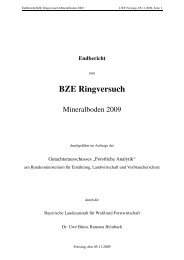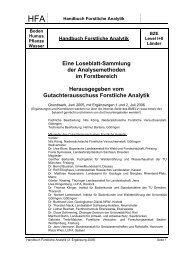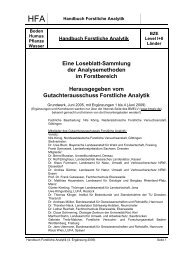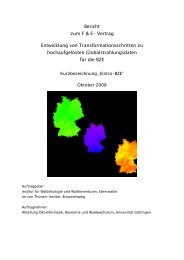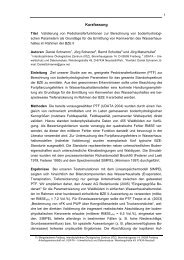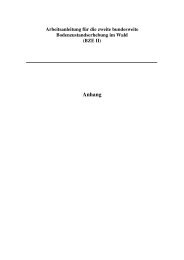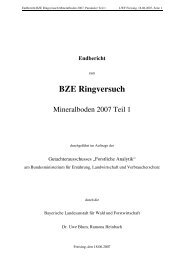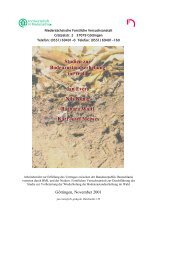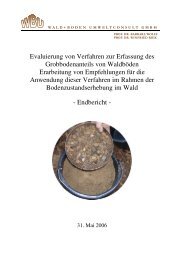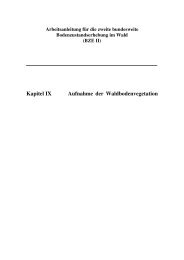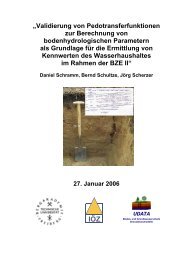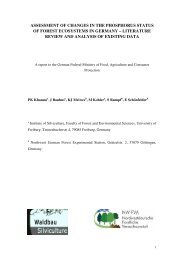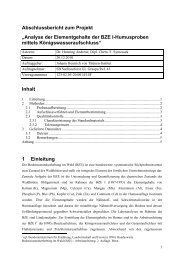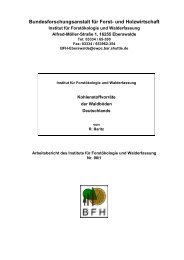assessment of changes in the phosphorus status of forest ...
assessment of changes in the phosphorus status of forest ...
assessment of changes in the phosphorus status of forest ...
Create successful ePaper yourself
Turn your PDF publications into a flip-book with our unique Google optimized e-Paper software.
upon soil and plant processes and <strong>the</strong> amount <strong>of</strong> P <strong>in</strong>puts. Among <strong>the</strong> several factors<br />
<strong>in</strong>fluenc<strong>in</strong>g <strong>the</strong> <strong>phosphorus</strong> concentrations <strong>in</strong> soil solution, soil pH, organic matter<br />
content, clay content, oxides <strong>of</strong> Fe and Al, carbonate content, uptake patterns <strong>of</strong> roots<br />
and microbes, and organic matter m<strong>in</strong>eralisation are <strong>the</strong> most important ones. To<br />
describe <strong>changes</strong> <strong>in</strong> P concentration <strong>of</strong> <strong>the</strong> soil solution, sorption iso<strong>the</strong>rms are used,<br />
which account for both <strong>in</strong>tensity and capacity factors <strong>of</strong> P equilibrium <strong>in</strong> soils. These<br />
two factors and <strong>the</strong> k<strong>in</strong>etics <strong>of</strong> P release and uptake constitute important parameters<br />
for predict<strong>in</strong>g <strong>the</strong> P supply<strong>in</strong>g characteristics <strong>of</strong> soils for optimum plant growth. Any<br />
soil test that <strong>in</strong>volves sorption iso<strong>the</strong>rms is considered more accurate than<br />
conventional P analysis methods (Klages et al. 1988) as iso<strong>the</strong>rms may <strong>in</strong>clude<br />
several factors mentioned above which <strong>in</strong>fluence <strong>the</strong> <strong>phosphorus</strong> dynamics <strong>in</strong> soil<br />
(Monterroso et al. 1996). P sorption iso<strong>the</strong>rms describe <strong>the</strong> amount <strong>of</strong> P required to<br />
br<strong>in</strong>g <strong>the</strong> concentration <strong>of</strong> P <strong>in</strong> <strong>the</strong> soil solution to an optimum level required for<br />
maximum plant growth.<br />
Concentrations <strong>of</strong> elements <strong>in</strong> soil solution can be used to calculate <strong>the</strong> so called ‘ Ppotentials’<br />
or ‘Sch<strong>of</strong>ield’s potentials’. These P potentials are related to lime potentials<br />
or pH values <strong>in</strong> <strong>the</strong> soil solution to obta<strong>in</strong> solubility diagrams. Such diagrams provide<br />
<strong>in</strong>formation on <strong>the</strong> predom<strong>in</strong>ant form <strong>of</strong> solid P which may be determ<strong>in</strong><strong>in</strong>g P<br />
concentrations <strong>in</strong> <strong>the</strong> soil solutions (Sch<strong>of</strong>ield 1955). One such diagram is given <strong>in</strong><br />
Fig 12 which was taken from Ulrich and Khanna (1968). This figure is based on 230<br />
<strong>forest</strong> soil samples from northwest Germany. All <strong>the</strong> values presented <strong>in</strong> <strong>the</strong> figure<br />
(pH, Ca, Al, P) were obta<strong>in</strong>ed <strong>in</strong> soil solutions by prepar<strong>in</strong>g saturation extracts <strong>of</strong> field<br />
moist soils.<br />
The Fig. 12 shows a number <strong>of</strong> categories, where soils <strong>of</strong> dist<strong>in</strong>ct groups were<br />
comb<strong>in</strong>ed. The groups were based on <strong>the</strong>ir soil pH (lime potential), calcium carbonate<br />
content, organic matter content, and soil depth (water logged soils, and those<br />
receiv<strong>in</strong>g fertilization were excluded). In soils <strong>of</strong> pH >6.8 and calcium carbonate <strong>of</strong><br />
>2% <strong>of</strong> soil weight concentration <strong>of</strong> P <strong>in</strong> <strong>the</strong> soil solution was def<strong>in</strong>ed by Ca-P forms,<br />
which were more soluble than apatite but less than octacalcium phosphates. In<br />
contrast, <strong>in</strong> soils with



